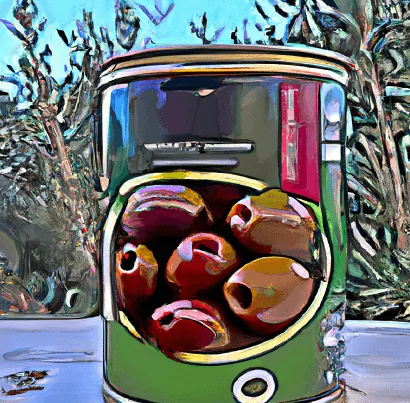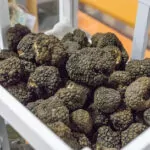When shopping for olives in grocery stores you might notice that the green olives are preserved in oil in a glass jar and black olives are packaged in a can. Why are black olives in cans and not jars?

Black olives are packaged in cans to accommodate the heating process that black olives need to undertake to prevent any bacterial growth. Green olives are not as ripe and do not have the same risk as black olives.
Below we will look at what leads to black olives needing to be canned.
Differences in the Olives
Black olives are ripe when they are picked and have their pits removed. Green olives typically still have their pits in them. The pits however are not the reason why the green olives are in jars and black olives are in cans. It all has to do with the health concerns of each type of olive.
Black Olives
Black olives, known as the California Ripe olive, were discovered by Freda Ehmann in the 1890s. She owned an olive ranch in Oakland California, and she contacted the University of California with tips on shortening the ripening process needed for olives. After months of work, she was able to refine the process and her business began to see significant growth which led to expanding her olive orchids across the country.
The original packaging for the black olives was barrels with loose seals. To prevent spillage, they were moved into glass jars. While this was able to hold the liquid in the jar it led to other and more disastrous results.
Tragedy Strikes
In 1919, an outbreak of botulism spread across three separate states and killed 19 people. [1] It is still considered one of the top ten deadliest food outbreaks in American history. It was traced back to olives that were manufactured and supplied by the Ehmann Olive Company.
In August of the same year, there was a dinner party in an Ohio country club that caused 14 people to become ill and seven to die. After some investigation by Epidemiologists, they were able to trace the outbreak back to the common food they had all eaten that night, black olives.
The waitstaff tasked with cleaning after the party began to sample some of the leftover food. They noticed a funky flavor when they tasted some of the olives that were served that night. When they informed the chef of their findings, he sampled two of the olives to determine if there was an issue with them. He later died as a result of eating the olives.
The Switch to Canning
The olive industry almost came to a halt for nearly a decade following the outbreaks. In 1925, The National Canners Association and California Canners League were able to take action and save the industry. [2] Procedures were set in place to can olives, tuna, sardines, and other vegetables. The cans needed to be heated to 240 degrees for 40 minutes to eliminate the risk of botulism.
The can is able to withstand the heating requirements while a glass container would bust during this process. The can was able to seal the olives and avoid the issues with spillage. The cans also increased the life of the olives. Before the discovery of botulism, olives and other food were not heated. When microscopic equipment was created, Epidemiologists were able to discover a better understanding of the bacteria.
They also discovered that riper fruit will release more gas and create an ideal environment for bacteria to grow. Since green olives are not as ripe as black olives, they do not need to be canned and will remain safe to consume if they are left in a glass jar.
Black olives are fully ripe and release a stronger amount of gas. They need to be preserved and stored in a can to prevent any bacteria from forming.
The Canning Process
The canning process for ripening and storing black olives was designed to eliminate the growth of bacteria and prevent the olives from becoming unsafe to consume.
Fresh green olives are picked and placed in a lye solution. Since lye is harmful to humans, the lye solution is diluted with water before the olives are placed in the solution. The olives are left in the lye solution for about two days. After they are removed, they are rinsed. The olives will have turned from green to black during this process due to the oxygen in the brine.
The lye allows the oxidation process to affect every part of the olive to the pit while still allowing it to remain edible.
After removal from the lye, the olives are moved to a brine solution. It also contains ferrous gluconate to achieve the black color of the olive. When the olives are set in the can, some of the brine is added to ensure the olive remains ready for consumption. The cans are sealed to prevent any spillage or bacterial growth.
The cans of black olives are then heated to 240 degrees for over 40 minutes to kill any bacteria that can be found in the olives. After this process, the black olives are ready for sale.
Conclusion
The canning process of black olives is necessary to heat the olives and prevent an outbreak of botulism. This process can not be completed in a glass jar because the glass can not withstand the heat needed during the process.
Glass jars are not as tight as cans and can lead to spoilage or wasting the olives. The cans provide the seal needed as well as the ability to withstand the heat needed when processing the black olives.
Green olives release less gas since they are not as ripe as black olives. They can remain in a glass jar since they are not required to undergo the same heating process that the black olive requires. They do not carry the same risk of bacteria and disease and are fit for consumption.
References:
[1]: https://www.jstor.org/stable/44451280
[2]: https://oac.cdlib.org/findaid/ark:/13030/c80g3n61/
- The Top Restaurants Specializing in Truffle Dishes - August 10, 2023
- Truffle Panna Cotta: A Decadent Dessert Recipe for Truffle Lovers - August 7, 2023
- Truffle Scrambled Eggs: A Luxurious Breakfast Delight - August 7, 2023








